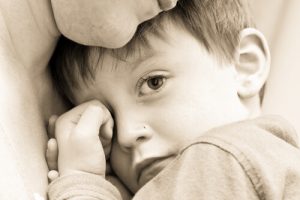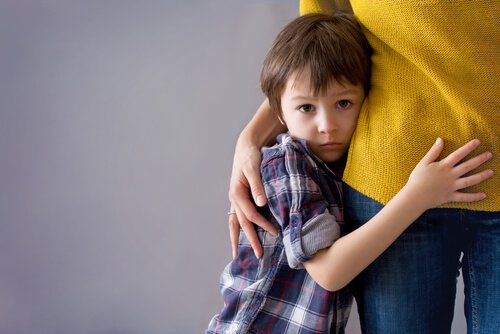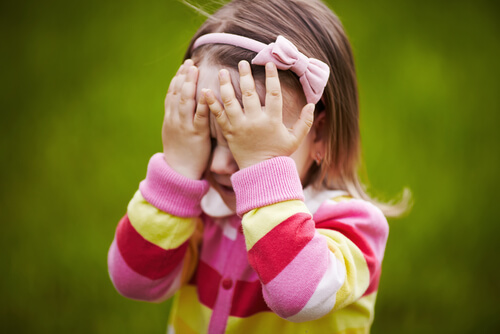Everything You Need to Know About Childhood Fear

Childhood fear is a universal phenomenon that occurs in all cultures. The only explanation is that fear is an important part of child development.
On a small scale, these feelings of fear in children are always unpleasant. On the other hand, they fulfill a survival function, like adapting to a situation that the child thinks is dangerous.
Likewise, when fear isn’t from a real cause, it can significantly alter a child’s ability to face everyday situations.
There is no doubt that fears are evolutionary and normal at a certain age. As the children grow and mature, their fear levels normally go down.
In spite of all this, in some cases, these fears can last longer. Sometimes they become disorders that need professional help.
Origins of childhood fear
1. Family patterns
Parents with a tendency to be afraid or with a history of anxiety disorders tend to have children with fears or anxiety more often than parents who are not.
2. Negative information
Negative information about a particular situation or stimulus can be a source of fear. Children will decide how they feel about something based on the situation and how those around them react to it.

3. Direct learning
There are some fears that children learn from direct learning. For example, the fear of not being able to breathe. This is the case in children who have had asthma attacks or woke up in the middle of the night unable to breathe.
4. Conditioning
Another way of acquiring fear is through conditioning. Think about a child who was burned by a firecracker exploding in his hand. In fact, it’s likely that even seeing them will make the child feel afraid.
5. Unpleasant experiences
Finally, other unpleasant or traumatic life experiences could cause fear in children. These include seeing mistreatment, fights, or emotionally impactful situations. Examples of those are accidents, the death of a loved one, among others.
In the worst case scenario, these fears can lead to more serious clinical disorders. These include specific phobias, generalized anxiety, or post-traumatic stress.
“Do that which you fear to do, and the fear will die.”
–Ralph Waldo Emerson–
How to fight childhood fear
When the fears are more severe, persistent, and significantly change the child’s normal rhythm with his family, school or environment, he may need special treatment.
Follow these tips to help your child combat fear:
Act normally
You shouldn’t show concern or frustration. Remember that children often internalize their parents’ moods and behaviors.
Don’t force the child to do what scares him
When it comes to fears that significantly affect the child’s development and daily life, you may need an intervention to help him.
Guide your child
Some psychological techniques use what’s called emotional staging. Using previous instructions, you can use different approaches to get the child to confront his fears.
The child needs to adopt the role of assistant or sidekick to his favorite hero. In fact, this treatment is most used in anxiety disorders, fears and phobias.
Act through a model
One of the parents can perform the dreaded behavior (for example, being in a dark room) to teach the child that nothing is wrong. However, it’s most effective when the model is the same age as the child.

Don’t laugh at your child
Always avoid laughing at your child about his fears, especially to his peers. Focus your attention on finding a solution, never ridiculing him.
Anxiety
Anxiety is also present in all things regarding fear. The term is used to highlight important psychophysiological changes. They occur in children’s body when they’re intensely afraid.
This can occur from a specific source or also without any stimulus. Simply, children feel anguish but can’t pinpoint exactly why they feel this way.
In short, don’t worry if your child has childhood fears. It’s completely normal and isn’t a cause for concern as long as they aren’t extreme. Use the tips from this article to help your child overcome it!
Childhood fear is a universal phenomenon that occurs in all cultures. The only explanation is that fear is an important part of child development.
On a small scale, these feelings of fear in children are always unpleasant. On the other hand, they fulfill a survival function, like adapting to a situation that the child thinks is dangerous.
Likewise, when fear isn’t from a real cause, it can significantly alter a child’s ability to face everyday situations.
There is no doubt that fears are evolutionary and normal at a certain age. As the children grow and mature, their fear levels normally go down.
In spite of all this, in some cases, these fears can last longer. Sometimes they become disorders that need professional help.
Origins of childhood fear
1. Family patterns
Parents with a tendency to be afraid or with a history of anxiety disorders tend to have children with fears or anxiety more often than parents who are not.
2. Negative information
Negative information about a particular situation or stimulus can be a source of fear. Children will decide how they feel about something based on the situation and how those around them react to it.

3. Direct learning
There are some fears that children learn from direct learning. For example, the fear of not being able to breathe. This is the case in children who have had asthma attacks or woke up in the middle of the night unable to breathe.
4. Conditioning
Another way of acquiring fear is through conditioning. Think about a child who was burned by a firecracker exploding in his hand. In fact, it’s likely that even seeing them will make the child feel afraid.
5. Unpleasant experiences
Finally, other unpleasant or traumatic life experiences could cause fear in children. These include seeing mistreatment, fights, or emotionally impactful situations. Examples of those are accidents, the death of a loved one, among others.
In the worst case scenario, these fears can lead to more serious clinical disorders. These include specific phobias, generalized anxiety, or post-traumatic stress.
“Do that which you fear to do, and the fear will die.”
–Ralph Waldo Emerson–
How to fight childhood fear
When the fears are more severe, persistent, and significantly change the child’s normal rhythm with his family, school or environment, he may need special treatment.
Follow these tips to help your child combat fear:
Act normally
You shouldn’t show concern or frustration. Remember that children often internalize their parents’ moods and behaviors.
Don’t force the child to do what scares him
When it comes to fears that significantly affect the child’s development and daily life, you may need an intervention to help him.
Guide your child
Some psychological techniques use what’s called emotional staging. Using previous instructions, you can use different approaches to get the child to confront his fears.
The child needs to adopt the role of assistant or sidekick to his favorite hero. In fact, this treatment is most used in anxiety disorders, fears and phobias.
Act through a model
One of the parents can perform the dreaded behavior (for example, being in a dark room) to teach the child that nothing is wrong. However, it’s most effective when the model is the same age as the child.

Don’t laugh at your child
Always avoid laughing at your child about his fears, especially to his peers. Focus your attention on finding a solution, never ridiculing him.
Anxiety
Anxiety is also present in all things regarding fear. The term is used to highlight important psychophysiological changes. They occur in children’s body when they’re intensely afraid.
This can occur from a specific source or also without any stimulus. Simply, children feel anguish but can’t pinpoint exactly why they feel this way.
In short, don’t worry if your child has childhood fears. It’s completely normal and isn’t a cause for concern as long as they aren’t extreme. Use the tips from this article to help your child overcome it!
This text is provided for informational purposes only and does not replace consultation with a professional. If in doubt, consult your specialist.








